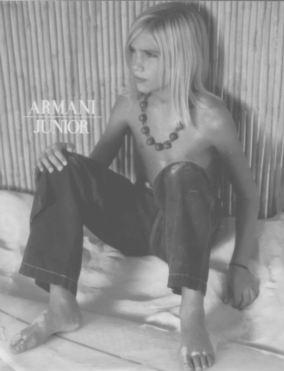Debate Guide: Reverse sexualization: Difference between revisions
mNo edit summary |
No edit summary |
||
| (7 intermediate revisions by one other user not shown) | |||
| Line 1: | Line 1: | ||
[[Image:Armani.PNG|thumb|Reverse- | [[Image:Armani.PNG|thumb|Reverse-sexualized by a British morality "Watchdog"]]By classifying any naked picture of a child as morally dangerous "pornography" worthy of [[censorship]], we admit that even prepubescent children's bodies arouse some erotic interest in society. It is indeed a bizarre quirk of Anglo-American orthodoxy, that the only "appropriate" response to depictions of naked or non-normative children is to complain of a "sexual" impropriety. Is this itself not only ''improper'', but prurient and counter to widely-accepted [[Research: Youth sexuality|evidence]]? This intuitive knowledge of children's aesthetic, erotic appeal, attests to how human desire is really an inter-meshing of conflicting and complimenting attractions. | ||
One example of reverse | One revealing example of reverse-sexualization comes from a Junior Armani poster (pictured), which was (astonishingly) criticized for sexualizing children back in 2004, leading to an ''upheld'' advertising regulator complaint.<ref>[http://news.bbc.co.uk/2/hi/uk_news/3706075.stm Armani advert slammed by watchdog]</ref><ref>[https://web.archive.org/web/20070323133318/http://www.geocities.com/pca_1978/art/armani/ Geocities page with rundown of controversy]</ref> 74 UK adult complainants had determined the pose to be "sexually inappropriate", as it carried connotations of precocity and agency - something they instinctively saw as unlocking the erotic potential of a child. It was the ''absence'' of "uglification" and [[infantilization]] that confounded the complainants, showing that what we are in fact desperately defending is an ''imposed'' moral standard, and not some sacred natural state. While we might 20 years later (in the era of "sharenting" Instagram Kids) look back and laugh at the ''Armani'' episode, the fact that we do, speaks to the instability of [[Childhood Innocence|childhood innocence]] as a notion. | ||
== | ==External links== | ||
*[https://www.independent.co.uk/news/uk/home-news/h-m-advert-banned-school-uniform-b2483076.html H&M advert banned] - Similar in the 2020s. | |||
==See also== | |||
*[[Childhood Innocence]] | |||
*[[Erotic Innocence]] | |||
==References== | |||
[[Category:Debate]][[Category:Debating Points: Child/Minor]] | [[Category:Debate]][[Category:Debating Points: Child/Minor]] | ||
[[fr:Guide de débat: Inverser la sexualisation]] | [[fr:Guide de débat: Inverser la sexualisation]] | ||
Latest revision as of 00:52, 17 February 2024

By classifying any naked picture of a child as morally dangerous "pornography" worthy of censorship, we admit that even prepubescent children's bodies arouse some erotic interest in society. It is indeed a bizarre quirk of Anglo-American orthodoxy, that the only "appropriate" response to depictions of naked or non-normative children is to complain of a "sexual" impropriety. Is this itself not only improper, but prurient and counter to widely-accepted evidence? This intuitive knowledge of children's aesthetic, erotic appeal, attests to how human desire is really an inter-meshing of conflicting and complimenting attractions.
One revealing example of reverse-sexualization comes from a Junior Armani poster (pictured), which was (astonishingly) criticized for sexualizing children back in 2004, leading to an upheld advertising regulator complaint.[1][2] 74 UK adult complainants had determined the pose to be "sexually inappropriate", as it carried connotations of precocity and agency - something they instinctively saw as unlocking the erotic potential of a child. It was the absence of "uglification" and infantilization that confounded the complainants, showing that what we are in fact desperately defending is an imposed moral standard, and not some sacred natural state. While we might 20 years later (in the era of "sharenting" Instagram Kids) look back and laugh at the Armani episode, the fact that we do, speaks to the instability of childhood innocence as a notion.
External links
- H&M advert banned - Similar in the 2020s.